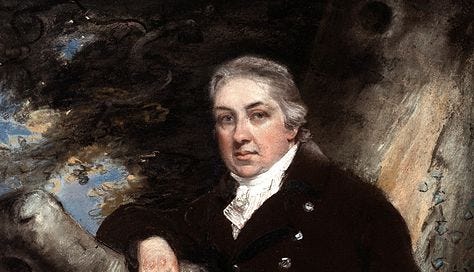Dr. Edward Jenner rode his horse through the serene English countryside amidst the morning mist clinging to the fields just after dawn on of May 14, 1796. His destination was a farm where a milkmaid, Sarah Nelmes, had developed cowpox, a mild disease that left sores on her hands.
While Dr. Jenner was a well-known physician who had worked in the region for almost twenty-five years, he wasn't coming to treat Sarah that day. Instead, he needed her help. The doctor had a simple yet profound hypothesis that was in part rooted in regional folklore: those who overcame cowpox were immune to smallpox, one of the deadliest and most feared diseases in human history. Highly contagious, it led to harrowing symptoms that included fever, fatigue, and vomiting in the early phases, followed by the appearance of a painful rash that developed into fluid-filled pustules. For those inflicted, smallpox had a mortality rate of approximately 30%, while survivors were often left with deep, permanent scars or blindness. In 18th-century Europe, the ailment claimed an estimated 400,000 lives annually, mainly children under the age of 10. In the Americas, the introduction of smallpox during European colonization wiped out the majority of some Indigenous populations.
At the time, the primary method of protection against smallpox was variolation. This procedure involved introducing material from smallpox pustules of people with the ailment into the skin of healthy individuals to induce a mild case of the disease. Doing so would confer immunity.
But the procedure was not without significant risks. While it did reduce mortality rates compared to contracting smallpox naturally, about 1%-2% of people still died from smallpox. Moreover, the procedure often frightened people, as it required deliberate exposure to the deadly virus.
Given this significant impact of smallpox, the stakes for success were high. If Dr. Jenner was correct, his work could save countless lives and change the course of medicine. As he said, "The annihilation of the Small Pox...must be the final result of this practice."
On that morning of May 14, Dr. Jenner took the material from a cowpox sore on Sarah's hand. Then, he returned home, where he inoculated his gardener's son. The boy developed a mild fever but recovered quickly. Weeks later, Dr. Jenner exposed him to smallpox, which he did not develop, proving the hypothesis.
Dr. Jenner published the findings in 1798, calling his discovery "variolae vaccinae," derived from the Latin "vacca" for cow. The term "vaccine" was born.
Despite the success of his experiments, Dr. Jenner faced skepticism and resistance along the way. He faced significant criticism and harassment in attempting to prove the hypothesis. After publishing his findings, critics questioned the safety of vaccination, with some alleging it could cause bizarre side effects. Satirical cartoons depicted vaccinated individuals sprouting cow-like features. Religious objections also arose later, particularly as vaccination became more widespread. Then there were the practical logistical challenges that emerged as cowpox was not readily available everywhere.
Still, the implications of Dr. Jenner's work would prove to be staggering. Smallpox had a formidable adversary, and as vaccination programs began sprouting across Europe and beyond, the number of people afflicted significantly declined. Furthermore, Dr. Jenner's work work became the cornerstone of modern immunology.
Sources:
“About Edward Jenner.” The Jenner Institute, https://www.jenner.ac.uk/about/edward-jenner
“Edward Jenner.” The British Medical Journal, vol. 1, no. 3239, 1923, pp. 163–64. JSTOR, http://www.jstor.org/stable/20422370. Accessed 12 Jan. 2025.
Levine, Israel E. Conqueror of Smallpox: Dr. Edward Jenner. Messner, 1960.
Morgan AJ, Parker S. Translational mini-review series on vaccines: The Edward Jenner Museum and the history of vaccination. Clin Exp Immunol. 2007 Mar;147(3):389-94. doi: 10.1111/j.1365-2249.2006.03304.x. PMID: 17302886; PMCID: PMC1810486.
Wikimedia Commons, Wikipedia Foundation, https://en.wikipedia.org/wiki/File:Edward_Jenner.jpg





As a retired RN I’ve always been interested in immunology. This is a very informative commentary on Dr. Jenner and his ground-breaking work. Today some people question the use of vaccines but I remember having the German measles as a child and it was not pleasant. People centuries ago who lost their children to smallpox would have been anxious to have a vaccine protect them from that terrible disease.